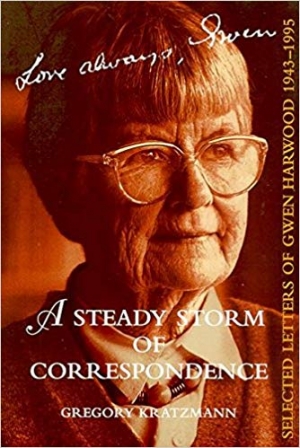Brenda Niall
Brenda Niall reviews 'A Steady Storm of Correspondence: Selected Letters of Gwen Harwood 1943–1995' edited by Gregory Kratzmann
‘I remember only peripheries, not centres,’ Michèle Drouan says in her memoir of marriage to a Jordanian and life with his family in a village near Jordan’s borders with Syria and Lebanon. Her perspective is deliberately oblique. Elegantly shaped, and or the most part gracefully written, her story bypasses the obvious cultural divisions. Political, religious, and sexual tensions are given minimal treatment. No dates are given: you would hardly know that the Gulf War comes within the book’s timespan, and when the sound of bombs is heard from across the border, someone quietly says ‘Lebanon’, and leaves it at that.
... (read more)Brenda Niall reviews 'Foreign Correspondence' by Geraldine Brooks
When Geraldine Brooks went through her father’s possessions after his death, she found the bundles of letters which prompted her to write Foreign Correspondence. Lawrie Brooks had been in the habit of writing to politicians and intellectuals with ideas and questions, and he had kept all their replies. Each letter, Brooks reflects, is ‘a small piece of the mosaic of his restless mind’. Because her father hoarded his past in photographs and newspaper clippings as well as letters, she had the makings of an intimate portrait of a reserved and unhappy man.
... (read more)Brenda Niall reviews 'Pomegranate Season' by Carolyn Polizzotto and 'Till Apples Grow on an Orange Tree' by Cassandra Pybus
Two autobiographical works, both by women historians, are presented in the elegant small format which often says ‘gift book’ and may suggest more surface charm than substance. In fact, there are at least as many contrasts as resemblances between the two, and although the mood is quietly reflective, there is no easy nostalgia.
... (read more)Brenda Niall reviews 'Correggio Jones and the Runaways: The Italo-Australian connection' by Desmond O’Grady
Desmond O’Grady is uniquely placed to interpret Australia for Italians and Italy for Australians. He grew up in suburban Melbourne, but as a journalist, biographer, and writer of fiction he has spent most of his working life in Rome.
... (read more)Brian McFarlane reviews 'Martin Boyd: A life' by Brenda Niall
When Martin Boyd returned to Australia in 1948 after twenty-seven years in England, he set about restoring the Grange, the derelict former home of his mother’s family, the à Becketts. He had been disappointed to find how little known his novels were in Australia and he had difficulty in re-establishing himself with the Boyd family. Nevertheless he persevered with his impulsive scheme until he could draw ‘the curtains at night in the little sitting room ... [and] indulge the illusion of being in an English manor house.’ Among the à Beckett portraits and eighteenth-century furniture were his nephew Arthur’s biblical frescoes. In trying to be an English squire in the Australian countryside, surrounded by the artefacts of two continents and centuries, Boyd presents the image of a man who never quite found himself wholly at home anywhere.
... (read more)





